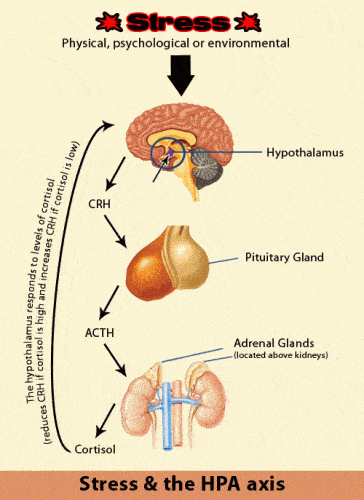
Stress and the stress response mean different things to different people but it is often viewed in a negative light. However, when triggered at appropriate times, stress is certainly not a bad thing. In fact, it can have a number of positive effects in the body as it triggers different organs in the body to take action.
So what is stress? Technically, stress is defined as a state in which homeostasis (balance) in the body is actually threatened or perceived to be threatened. Stress can be triggered by a range of psychological and physical ‘stressors’. The list of potential stressors in almost endless with common psychological stressors including relationship conflict, excess work demands, past trauma, financial pressures, exam and study stress, the list goes on. Psychological stress does not even need to be triggered by ‘real’ events. Imagined events can have just as much far-reaching consequences on our stress response. Stress can also be triggered by physical stressors including illness, inflammation, medical conditions, starvation, allergic reactions, toxin exposure, poor sleep, etc.
When our body is stressed it triggers a hormonal response in the body known as the ‘HPA (hypothalamus-pituitary-adrenal) axis’ (stress response). This process is outlined in the figure below. Stress (whether physical or psychological) sets off neurons in the hypothalamus (a part of the brain) to release a hormone known as corticotrophin-releasing hormone (CRH). CRH is then transported to the pituitary gland (another part of the brain) which then secretes another hormone, adrenocorticotropic hormone (ACTH). ACTH then stimulates the adrenal cortex (part of the adrenal gland) to secrete cortisol. To keep the system in balance, a negative feedback system is in play. This basically means that high levels of cortisol trigger the hypothalamus to reduce its output of CRH which in turn lowers the levels of ACTH and cortisol.

While more research is required in order to identify all the causes of HPA imbalances, studies so far have revealed that imbalances can be caused by a number of factors including genetic variations (genes), developmental history, current and past psychological and physical stressors, nutrition, environmental exposures, physical health and aging.
For example, studies show that people exposed to high stress (physical or psychological) as infants and children (and even as early as a foetus) can have a more ‘sensitive’ HPA axis which can be set-off by minor triggers (they have a more sensitive stress response). People also exposed to ongoing (chronic) stress, therefore tend to have high circulating cortisol levels in their body can experience neuronal damage in the brain. This, in turn, affects the response of the HPA axis, which may not be able to turn itself off effectively. Studies actually show that people exposed to prolonged stress can have damaged areas in different parts of the brain.
Dr. George Chrousos[1], a prominent stress researcher, has reported that HPA and cortisol imbalances are associated with a range of health problems. The table below lists the conditions associated with either too much cortisol (increased HPA axis activity) or too little cortisol (decreased HPA axis activity):
Increased activity of the HPA axis
Decreased activity of the HPA axis
Normalising the HPA Axis imbalance is often an important step in resolving mental and physical health problems and reducing the stress response. Unfortunately, the solutions are often not simple and cannot be resolved through a magic pill. The most effective treatment is multi-faceted which means that it targets the problem from a number of different directions. Treatments usually include a combination of psychological, environmental, lifestyle, nutritional, physiological and medical solutions. While not always possible, the ultimate goal is to target the cause(s) of HPA imbalances and treat any other corresponding consequences of HPA imbalances. While the list is not exhaustive, the figure below lists possible treatment options for HPA imbalances.
As has been demonstrated, when working correctly and when given time to have a break, our stress response can be our ally. However, for many people suffering from mental and physical health problems, HPA imbalances and a sensitive stress response can be a major issue that requires appropriate assessment and treatment. Tests are available to assess the health of the HPA axis and the effects it has on different body systems. Following an appropriate assessment, effective treatments can be implemented in an attempt to reduce suffering and enhance overall health and well-being.
If you are a mental health practitioner and would like to discover a range of integrative strategies to offer your clients, then make sure you don’t miss the 2-day PI Therapy Workshops. CLICK HERE to find out more.
If you are interested in using PI Therapy to enhance your personal mental wellbeing, CLICK HERE to find out more.